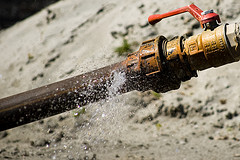 Detecting damage to your underground storage tank is really about detecting leaks – the result of damage. But you can’t see below the surface, so it’s essential to have a comprehensive, reliable monitoring system that can “see” for you.
Detecting damage to your underground storage tank is really about detecting leaks – the result of damage. But you can’t see below the surface, so it’s essential to have a comprehensive, reliable monitoring system that can “see” for you.
All regulated tanks – including your underground storage tank – must be accompanied by some kind of release detection equipment that allows you to discover and correct problems as quickly as possible, hopefully before any contamination can spread into the soil or groundwater. Your leak detection system must:
- Be capable of detecting a leak from any part of your tank or any associated piping that regularly comes in contact with any hazardous substance.
- Follow the manufacturer’s instructions for installation, calibration, operation and maintenance.
- Meet applicable federal performance regulations.
You must monitor your tank monthly.
There are several ways to do this:
- Secondary containment with interstitial monitoring is becoming more widely used, as it provides better protection, through double-walled tank construction or by placing the tank in a vault or liner.
- Automatic tank gauging monitors are permanently installed inside the tank and communicate electronically with a nearby control device.
- You may monitor for vapors in the soil and liquids in groundwater using carefully-located monitoring wells that can be checked electronically or manually.
- Statistical inventory reconciliation is a software application that collects and analyzes inventory, delivery and dispensing data to identify leaks.
- Your regulatory agency may approve some other method.
If your underground storage tank is new, or you’ve upgraded an existing tank with corrosion protection, you may implement a Monthly Inventory Control and Tank Tightness program every five years. But only for ten years, then you must switch to monthly monitoring.
If your underground storage tank that holds less than 2000 gallons, and you meet all the pertinent requirements, you might be allowed to use manual tank gauging to monitor for leaks. However, in order to conduct the test, you’ll have to take your tank out of service for 36 hours each week. Manual monitoring may be used alone for tanks that hold less than 1000 gallons; otherwise, you also need to regularly test your tank for tightness. Regardless, after five years, you’ll need to switch to another monitoring system.
The piping attached to your tank must be monitored, too.
If you’re using pressurized piping, you can install an automatic shutoff device, or a flow restrictor, or a continuous alarm system. You also have to implement annual line testing or monthly monitoring using one of the methods described above, except that automatic tank gauging doesn’t apply to pipes.
For suction piping, you can use one of the monthly monitoring systems or you can implement line testing every three years. You may be able to avoid ongoing monitoring altogether, if your tank and piping set-up:
- Slopes below-grade, allowing the pipe’s contents to drain back into your underground storage tank whenever suction is released.
- Has a check valve for each suction line located right below the suction pump.
- Operates at less than atmospheric pressure.
Damage to your underground storage tank can damage your finances and reputation, too.
You’ve got your tank and piping monitoring systems in place, so you’re good so you don’t need to give it another thought, right? Wrong. You have to record your monitoring results to meet regulatory compliance standards. If your system does indicate a leak, you must report that potential release right away. It may lead to an underground storage tank removal which you can learn more about by following the link.
Most importantly, you have to maintain your system to ensure it’s working properly, and keep records of that, too. If your equipment is out of calibration or it’s not working, you’ll get inaccurate data or you won’t even know there’s a leak. You’ll be out of compliance, so you could face fines. Worse, you could be looking at substantial remediation costs.
With the right monitoring system and a conscientious maintenance plan in place, you won’t have to worry about damage to your underground storage tank. Leaks can become just as big of a problem with above ground tanks so take a look at this article around above ground storage tank spills and leaks.
